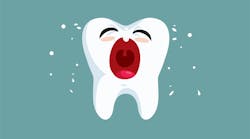Finding the best way to bond
Michael Miller, DDS
What is the best way to bond a post into the canal, then follow up with either a dual or self-cure CBU? For instance, if I use Panavia (Kuraray America) for the post, the ED primers are not enough for bonding the core and it is very difficult — if not impossible — to use two primer/adhesive systems on the same tooth. Should I use Panavia, let it set up after post placement, then freshen up remaining dentin in preparation for total etch and prime/adhesive, and apply the CBU material? Or should I use the total etch protocol, with the same primer/adhesive system in the canal space, and place post with Calibra (Dentsply Caulk) dual cure (for example), followed by immediate placement of the CBU?
Both of these examples would work, but the total etch is easier. You can allow the post cement to set first (if using a self-cure cement) or light-cure the dual-cure cement immediately after seating the post, then do the core buildup after the post is rigidly luted. This technique gives you more control, and, when using a total etch type of adhesive, does not require any additional adhesive for the core. The simultaneous technique can also work well, but you have less control over the positioning of the post. In any event, there is very little, if any, advantage to using a self-etching adhesive in this instance.
I have an irregularly attending patient (a 16-year-old female) who, after a long absence, shows up with an anterior Hawley with two acrylic teeth on it to hold the space for the congenitally missing maxillary lateral incisors. The patient and the father state that they are ready to proceed with two dental implants to replace the missing teeth. On initial observation, I advise the patient and her father that there may not be enough room and that she may need to go back to orthodontics and wear braces again (oh, the wailing!). I now have study models and X-rays. Could you give me any guidelines in assessing this case? Since I understand that implants are not done until the patient is in her late teens, the father and patient mentioned that perhaps she could have two Maryland bridges as temps instead of the removable retainer. I was skeptical since both abutment teeth are virgin teeth and there is prepping involved in a Maryland bridge. Do you have any suggestions for a "fixed" temp?
While the Golden Proportion used to be thought of as a reliable guide for tooth sizes, this is no longer the case. Your best guideline would be the length-to-width ratio of the lateral incisors. If it varies from 10:8, meaning the length would be 10 mm and the width would be 8 mm, then you probably will need more width. Obviously, lateral incisors are usually not 10 mm long, so just use this as a ratio. If more width is necessary, you can "slenderize" the central incisors and canines if that procedure won't cause the centrals to be too narrow. This "slenderizing" is done safely with sandpaper discs rather than diamonds. If you or the patient does not want to prepare the teeth in any manner, then distalizing the canine and posterior teeth via orthodontics would be necessary. Distalizing can be done with fixed appliances or Invisalign. As far as "fixed" temporary bridges are concerned, preparation only needs to be done if clearance is an issue. But, even if you do need to prepare, the preparations can be small Class III cavities. Even if you remove the bridges in the future for implants, the wings in these preparations can be retained and should have a very long duration.
Please see the updatedsection on "Bridges With Partial Coverage Retainers" in the brand new edition of REALITY — THE TECHNIQUES, which came out in early December.
I have heard there is some evidence that while self-etching products like Clearfil SE (Kuraray America) have good bond strength at 24 and 48 hours, they have shown a big drop in strength at year two as compared to restorations that are etched with phosphoric acid and regular adhesive. Is there any truth to this?
Regardless of whether an adhesive is self-etching or not, there is a loss of bond strength over time through hydrolysis — or so the theory goes. This is one reason restorations dislodge. While we are not familiar with the "evidence" you mentioned, we would urge caution when interpreting these types of results. From a clinical perspective, there have been virtually no reports of this "mass debonding."
Now I use 20/40 seconds to cure composite/bonding with my Heraeus Kulzer Translux curing light (500mW/cm2, seen at right). Will I use half this time if I use a light with twice as much power (1000mW/ cm2)? If so, does that go for all light-curing? Does double the power mean half the time?
Curing times are dependent on several criteria, such as power of the light, distance of the tip from the bottom of the preparation, etc. You can't just double the power and expect to cut your curing time in half. It just doesn't work that way. We have a new industrial-type radiometer that measures output regardless of whether the light is halogen, LED, plasma arc, etc. We are currently correlating these readings with depth-of-cure and bond strength. The results of all these tests will be in the 2003 annual edition of REALITY.
In the meantime, if you use a light that has a power reading of 500mW/cm2, you would be best advised to continue to cure most restorations for 40 seconds per increment. The exception would be a shallow Class V, where you can get the light tip within 1.0 mm of the restoration. If you use a hybrid, you can drop your curing time to 20 seconds, but if you choose a microfill, stay with 40 seconds.
Looking for more information on the companies mentioned?
Dentsply Caulk—www.caulk.com
Heraeus Kulzer—www.kulzer.com
Invisalign—www.invisalign.com
Kuraray America—www.kurarayamerica.com
Dr. Michael Miller is the publisher of REALITY and REALITY Now, the information source for esthetic dentistry.

